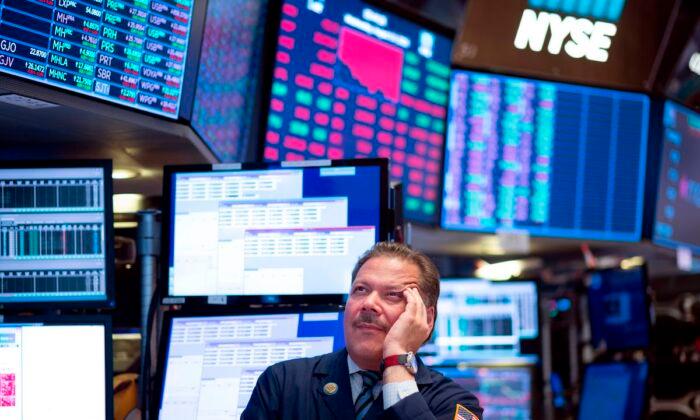As key Wall Street indexes extended their losing streak on Feb. 27, experts pointed to a growing concern among investors that the effects of broken global supply chains due to the novel coronavirus (COVID-19) may be greater than previously thought.
“COVID-19 brought the production and transportation of many goods to a near standstill from which they have not yet recovered, and at a time when pandemic concerns are still rising,” said Allen Sukholitsky, chief macro strategist at Xallarap Advisory.
He told The Epoch Times in an email that concerns over broken supply chains are one reason investors are fleeing risky assets.
“Quarantines. Closed borders and ports. Suspended flights and freight,” he said, adding that “equities are reacting to the implied impact of almost 80,000 confirmed cases of COVID-19.”
“Records are being broken across asset classes,” he said.
The benchmark 10-year Treasury note, viewed as a haven bet in times of crisis, hit a record-low yield of around 1.24 percent Feb. 27, while the 30-year Treasury bond set a new all-time low last week. Bond yields move in the opposite direction to prices, with falling yields a sign of capital fleeing to a safe harbor.

Supply Chain Impact ‘Significantly Larger’
“The impact on supply chains is significantly larger than most analysts expected,” economist Daniel Lacalle told The Epoch Times in an emailed statement.Lacalle said estimates indicate the supply chain disruption could shave “at least 0.7 percent of GDP” off global growth, citing PricewaterhouseCoopers research that he said employed the same kind of methodology that was used to estimate the impact of SARS (severe acute respiratory syndrome).
A key risk for businesses is exposure to supply chains that are dependent on imports from China, where parts of provinces that count for some 89 percent of the country’s exports remain in lockdown.
‘A Devastating Indictment’
One such risk is U.S. dependence on drug imports from China.“A U.S. economy heavily reliant on vital medicines and their ingredients from an increasingly hostile and secretive China is a devastating indictment of pre-Trump national security and public health policy,” said trade expert Alan Tonelson, in an emailed statement.
“But the purely economic effects shouldn’t be overlooked either, as globalist leaders also encouraged the buildup of China as a huge global manufacturing hub, and thereby exposed Americans to the risk of shortages and other supply chain risks in a wide variety of critical products.”
“I was alarmed to learn recently that almost 90 percent of the active ingredients used in pharmaceutical manufacturing originate in China,” said Rep. Kay Granger (R-Texas.) “What should we be doing in the United States to ensure the safety of the American drug supply?”
Azar said “aggressive” steps had been taken to ensure an uninterrupted supply of key pharmaceuticals amid the virus outbreak, but said other medical supplies might be affected.
Small Business Disruption
So far, big corporations have dominated the virus-related business disruption headlines, with an outpouring of coverage around Apple’s recent earnings downgrade announcement, and its subsequent stock dip and broader risk asset selloff. But small U.S. businesses have also been hit.Wil Knibloe, a partner at Crowe LLP, a risk consultancy, told The Epoch Times in a statement that he’s directly aware of multiple small businesses that have been affected by late product deliveries, extended lead times, and “future supply chain stability uncertainty in general.”
Knibloe identified several businesses—including a furniture maker and tech products manufacturer—that face problems due to “lost sales because of lack of available finished goods products, expedited shipping costs of late components, and/or finished goods to plants and markets, as well as the cost of backup sources.”
Smaller businesses are often more vulnerable to broken supply chains than their bigger counterparts, said Brandon Renfro, assistant professor of finance at East Texas Baptist University.
“Small businesses, particularly retail, will likely see an issue in regards to keeping inventory,” Renfro said in an emailed statement. “If factories in China are shut down, that means the local retailers who carry products manufactured in China can’t restock. For a very small business, the issue is even worse because what large corporations call quarterly profits, small businesses call ‘food and utilities money.’ They just often aren’t as capable of weathering a squeeze.”
One consequence of the disruption is that it may force businesses to recalibrate their supply chains.
“Now, U.S. firms may more seriously consider onshoring manufacturing capacity in order to limit further disruption from global supply unpredictability,” Jimmy Hinton, senior managing director at Transwestern, said in an emailed statement to The Epoch Times.
But for any mitigation efforts to succeed, according to Mike Varney, a partner at Crowe LLP, businesses must first gain “a clear understanding of the various nodes in their supply chains.”
“Visibility throughout the supply chain is critical,” Varney told The Epoch Times in an emailed statement, adding that a quick fix could be to find alternative sources, spurred by a disruptive event such as COVID-19.
But he advised forward-thinking businesses to develop detailed mitigation strategies for different segments of their supply chains well in advance of any crisis.
“These strategies can include alternative sourcing solutions, alternative production sites, or safety stock,” he said.





